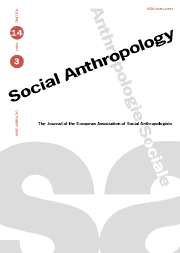Death and the ideology of compensation among the Wodani, western highlands of Irian Jaya
Published online by Cambridge University Press: 01 October 1999
Abstract
This article is a case study which deals with the consequences of a conflict among the Wodani. It describes the irruption of a Cargo Cult in this remote region of New Guinea, a series of incests provoked by the millenarian ideology, followed by murders and internecine war within the Kundiyau clan and, finally, the attempt to resolve these disorders through the organisation of a homicide payment, which, thanks to an unexpected juridical fiction, is collected not from the murderer but from a clan-brother of the incestuous prophet. These developments allow us to consider a number of more general questions: the notion of incest, of clan affiliation and personal identity in Wodani society; the compensation system allowing for the establishment of an equivalence between human lives and means of payment; the eschatological doctrine explaining the reproductive function of shell money; the theory of causality and juridical responsibility justifying a fictitious charge of murder; and finally, the future of the traditional currency in a society which is now compelled to reformulate its cosmological principle of compensation.
- Type
- Research Article
- Information
- Copyright
- © 1999 Cambridge University Press
Footnotes
- 3
- Cited by




